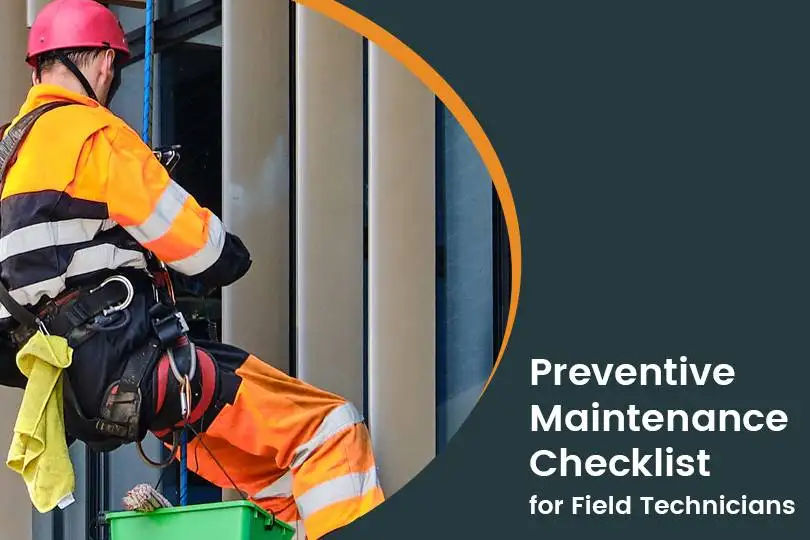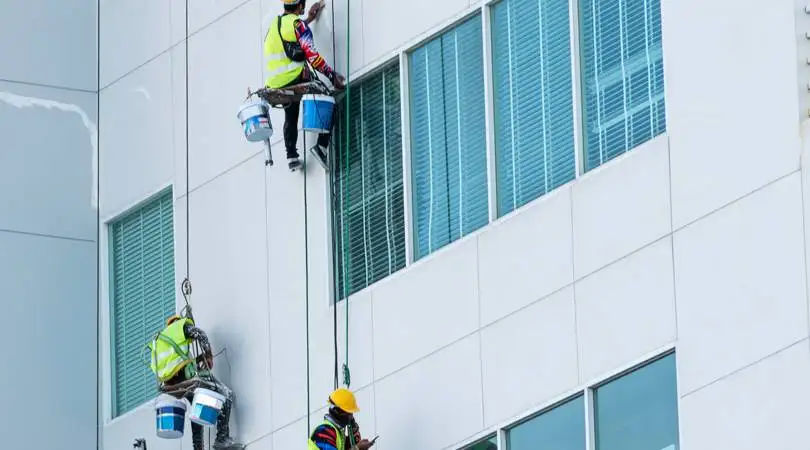Preventive Maintenance Checklist for Commercial Buildings: The Complete Guide for Field Technicians with Free Template

Maintaining commercial buildings is a complex task that demands careful planning and execution. Preventive maintenance is a key strategy to ensure the longevity and efficiency of commercial structures. It serves as a proactive strategy to ensure the sustained functionality, safety, and longevity of the property.
By regularly inspecting and addressing potential issues before they escalate, businesses can avoid costly emergency repairs, minimize downtime, and extend the lifespan of critical systems and equipment. This approach not only contributes to substantial cost savings but also enhances energy efficiency, ensuring optimal performance of HVAC, electrical, and plumbing systems.
Ready to get started with Field Promax?
Sign Up FreeDespite its growing urgency, keeping up with efficient preventive maintenance poses unique challenges due to the complex and multifaceted nature of these structures. First and foremost, the vast array of building systems, from HVAC and electrical to plumbing and safety features, demands meticulous attention and coordination. Scheduling routine maintenance without disrupting daily operations is a delicate balancing act, requiring careful planning to minimize downtime.
Additionally, the sheer scale of commercial buildings often means a large number of assets and equipment to monitor, making it challenging to maintain comprehensive and accurate records. Budget constraints and resource allocation further compound the difficulties, as businesses must balance the need for preventive measures against other operational priorities.
Despite these challenges, the long-term benefits of preventive maintenance, such as cost savings and enhanced operational efficiency, make overcoming these hurdles imperative for the sustained success of commercial buildings. To this end, a commercial preventive maintenance checklist serves as a strategic roadmap.
In this comprehensive guide, we will delve into the world of preventive maintenance for commercial buildings, exploring its definition, benefits, and ground rules for preparing a preventive maintenance checklist and providing a handy template. So, if you are looking for some useful resources for commercial preventive maintenance, keep reading.
What is Preventive Maintenance for Commercial Buildings?
Before we delve into the intricacies of a checklist, let’s try to understand the basics—what is preventative maintenance and why is it important?
By definition, preventive maintenance is a proactive approach to building upkeep that involves scheduled inspections, repairs, and replacements of equipment and systems. In the context of commercial buildings, this strategy aims to identify and address potential issues before they escalate, ensuring smooth operations and minimizing costly downtimes.
Using preventative maintenance, you can lower your overall maintenance costs, improve the scheduling of preventative maintenance activities, and be more prepared for maintenance work with the right supplies, parts, and labor.
What is A Preventive Maintenance Checklist?

A preventative maintenance checklist, also called a facility maintenance checklist, is an invaluable security tool to keep a building safe through periodical planning, checkups, and maintenance activities.
It is the job of facility management teams to upkeep various aspects of commercial building maintenance that get weathered by environmental conditions, worn out by frequent use, or just expire because of the technical capabilities of the materials included. A preventive maintenance checklist plays an integral role in doing the job efficiently.
The checklist typically includes items such as HVAC system inspections, commercial electrical system checks, plumbing assessments, structural examinations, and safety system verifications. By adhering to a preventive maintenance checklist, businesses can identify and address potential issues before they escalate, reducing the likelihood of costly repairs, enhancing the building’s overall efficiency, and promoting a safe and comfortable environment for occupants.
The checklist provides a structured framework to ensure that no critical aspect of the building’s maintenance is overlooked, contributing to its sustained operational excellence.
Benefits of Preventive Maintenance Checklist for Commercial Buildings
Irregular adherence to a facility maintenance checklist can cause mild issues in shorter periods and severe, even life-threatening security problems down the line. For example, a mild issue can include the failure of parts of the IT infrastructure that can prevent people from doing their daily work. A severe issue, on the other hand, can be a power cut in a facility that doesn’t have a backup generator, which endangers substances or materials that must be kept under specific temperature conditions, in turn causing serious consequences to people’s health or lives. Therefore, it’s critical for every facility to create a facility maintenance template, in which it will describe the necessary steps needed to be taken to keep everything safe and in order.
Here are some more benefits of using preventive maintenance checklists for commercial building maintenance:
1. Cost Savings
Preventive maintenance helps identify and address potential issues before they become major problems, minimizing the need for costly emergency repairs.
2. Extended Equipment Lifespan
Regular inspections and maintenance activities contribute to the prolonged lifespan of critical building systems and equipment, reducing the frequency of replacements.
3. Reduced Downtime
Proactively addressing issues through preventive maintenance minimizes unexpected breakdowns, ensuring that commercial operations run smoothly with minimal downtime.
4. Enhanced Energy Efficiency
Regular maintenance of HVAC, electrical, and plumbing systems ensures optimal performance, leading to reduced energy consumption and lower utility costs.
5. Improved Safety
Identifying and rectifying potential safety hazards in advance creates a safer environment for occupants, reducing the risk of accidents and liability issues.
6. Increased Tenant Satisfaction
Well-maintained commercial spaces provide a comfortable and reliable environment, leading to higher tenant satisfaction and retention.
7. Preservation of Asset Value
Preventive maintenance safeguards the physical integrity of the building, protecting its overall value and supporting long-term asset appreciation.
8. Compliance with Regulations
Regular inspections and maintenance activities help ensure that commercial buildings comply with safety and regulatory standards, avoiding potential fines and legal issues.
9. Effective Resource Allocation
By scheduling maintenance tasks in advance, businesses can allocate resources efficiently, avoiding the need for sudden, unplanned expenditures.
10. Streamlined Operations
A preventive maintenance checklist provides a structured framework for maintenance teams, helping them prioritize and organize tasks, resulting in more streamlined and efficient operations.
How to Prepare A Preventive Maintenance Checklist for Commercial Building: Step-by-Step Guide

Step 1: Understand Your Building
Before diving into checklist creation, conduct a thorough assessment of your commercial building. Identify and categorize all critical systems, equipment, and components. This includes HVAC systems, electrical panels, plumbing, safety features, structural elements, and more. Understanding the intricacies of your building sets the foundation for an effective checklist.
Step 2: Refer to Manufacturer Guidelines
Consult the manufacturer’s guidelines for each piece of equipment and system in your building. These guidelines provide valuable insights into recommended maintenance schedules, procedures, and any specific requirements. Adhering to manufacturer recommendations ensures that your commercial preventative maintenance efforts align with industry best practices.
Step 3: Determine Maintenance Frequencies
Establish the frequency of inspections and maintenance tasks based on factors such as equipment type, usage patterns, and industry standards. Critical systems may require more frequent checks, while less crucial components may have a less rigorous schedule. Striking the right balance in your maintenance checklist ensures thorough maintenance without causing unnecessary disruptions.
Step 4: Document and Record-Keeping
Create a system for documenting maintenance activities. Keep detailed records of inspections, repairs, and replacements. This historical data not only serves as a guideline for creating a comprehensive building maintenance checklist but also as a reference for future maintenance decisions. It also helps track the performance and condition of building systems over time.
Step 5: Prioritize Critical Systems
Identify critical systems and components that are crucial for the building’s operations. Prioritize their maintenance to ensure their optimal functionality. This proactive approach minimizes the impact of potential failures on daily operations and helps allocate resources effectively.
Step 6: Customize Checklists for Each System
Tailor your checklist to suit the specific needs of each system or piece of equipment. Generic checklists may overlook unique requirements, so customization is key. Include detailed tasks for each component, ensuring a thorough examination during inspections.
Step 7: Incorporate Safety Checks
Integrate safety checks into your office building maintenance checklist. This includes testing fire alarm systems, emergency exits, security features, and any other safety-critical elements. Ensuring a safe environment for occupants is a paramount responsibility.
Step 8: Regularly Review and Update
A preventive maintenance checklist is not a static document. Regularly review and update it to reflect changes in building systems, equipment, or industry best practices. Adapt the checklist based on lessons learned from past maintenance activities.
Step 9: Leverage Technology
Consider using field service management software or specialized preventive maintenance tools like Field Promax to streamline the checklist creation and execution process. These technologies can help automate scheduling, track maintenance activities in real-time, and generate comprehensive reports.
Step 10: Training and Communication
Ensure that your maintenance team is well-trained on the commercial building maintenance checklist procedures. Effective communication is key to the successful implementation of preventive maintenance. Clearly outline the roles, responsibilities, and expectations for all team members involved.
Commercial Building Preventive Maintenance Checklist Template
If you find creating preventive maintenance checklists challenging, we are here to help. Find this free checklist template below, download it, and customize it as per your requirements.

For more information, contact Field Promax
We're here to help you get started
Conclusion
In today’s digital age, having a comprehensive preventive maintenance checklist for your commercial buildings is not enough. Leveraging advanced technology is crucial for efficient preventive maintenance in commercial buildings. Field Promax stands out as a comprehensive field service management solution designed to enhance preventive maintenance processes.
Field Promax stands out as an invaluable asset in the realm of preventive maintenance for commercial buildings, offering a comprehensive suite of features designed to enhance efficiency and streamline maintenance operations. With its robust scheduling and planning capabilities, Field Promax enables businesses to effortlessly manage preventive maintenance tasks for various systems and components within a commercial building.
The software’s user-friendly interface facilitates easy customization of preventive maintenance checklists, allowing businesses to tailor the tasks to the unique requirements of their buildings. Field technicians can access and update these checklists in real time through the mobile app, ensuring that inspections and maintenance activities are recorded promptly and accurately, contributing to a more efficient workflow.
What sets Field Promax apart as the best choice for implementing preventive maintenance is its seamless integration capabilities. The software can be easily integrated with other essential business systems, such as accounting and customer relationship management (CRM) software. This integration ensures a holistic approach to commercial building maintenance, allowing for streamlined communication and data sharing across various departments.
Furthermore, Field Promax’s customizable templates, real-time reporting, and advanced analytics empower businesses to make informed decisions based on accurate insights. By automating and optimizing preventive maintenance processes, Field Promax emerges as a transformative solution, maximizing the effectiveness of commercial building maintenance and ensuring that businesses can proactively address issues before they become major problems.
So, what are you waiting for? Explore the power of Field Promax and experience a new era of preventive maintenance. Sign up now.